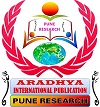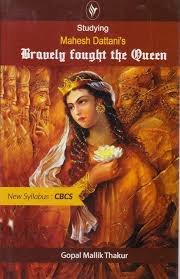VOL- 9, ISSUE- 2, PUNE RESEARCH TIMES (ISSN 2456-0960) JIF 4.06
9.2 SCHOLAR
Area of Article : ALL

VOL- 9, ISSUE- 2, PUNE RESEARCH TIMES (ISSN 2456-0960) JIF 4.06
9.2 SCHOLAR

VOL- 9, ISSUE- 2, PUNE RESEARCH TIMES (ISSN 2456-0960) JIF 4.06
9.2.1 SCHOLAR

This paper investigates Mahesh
Dattani's renowned play, "Bravely Fought the Queen," from a feminist
perspective, aiming to unravel its portrayal of female characters and its
treatment of gender issues within the context of Indian society. The analysis
seeks to uncover how the play defies conventional gender norms and empowers its
female protagonists, thereby presenting a nuanced and thought-provoking view of
feminism in Indian theatre. At the heart of "Bravely Fought the
Queen" is the character of Dolly, a woman who defies societal expectations
and navigates the complexities of her identity and agency. Through Alka’s
journey, the play challenges the audience to re-examine their perceptions of
femininity and women's roles in society. The protagonist’s defiance of
traditional gender roles and her pursuit of personal freedom serve as a
powerful statement against the constraints imposed on women by a patriarchal
society.
VOL- 9, ISSUE- 2, PUNE RESEARCH TIMES (ISSN 2456-0960) JIF 4.06
9.2.2 TIMES

This paper investigates
various views of the novel I Too Had A Love Story by Ravinder Singh. Ravinder
Singh’s (February 4, 1982) first autobiographical novel is I Too Had A Love
Story. It is full of his emotions and unconditional love for Khushi who is
known to him through matrimonial website. His novels have themes like emotion,
care, romantic relationships, personal tragedy, friendships, marriage,
sexuality, family, conflict, among other topics. He especially wrote about
tragedies in his life. Young adult narrative writer Ravinder Singh reveals
several social issues, including true unconditional love family conflicts,
relationship problems and the sentiment of warmth in his writings. I Too Had A
Love Story is a tribute to Ravinder’s girlfriend who died before their
engagement the story suggests that not all love stories are meant to have a
seamless ending. I Too Had A Love Story
is one such immortal saga. This heartbreaking true life story has already
touched a million hearts. It is the tender and heartfelt tale of Ravin and
Khushi, two people who find each other on and fall in a matrimonial site love,
until life puts their love to the ultimate test.
VOL- 9, ISSUE- 2, PUNE RESEARCH TIMES (ISSN 2456-0960) JIF 4.06
9.2.3 TIMES

The research paper titled
"Enhanced Anti-Theft System (EATS) based Robber Notification using theft
image correction: A Fuzzy Logic Technique (FLT)" delineates an innovative
approach towards boosting security measures against theft incidents.
Traditional security systems often struggle with accurately identifying thieves
due to image distortions and environmental factors. In this case, the captured
images of the theft are sometimes not correct or raw in nature due to
surrounding disturbances or limitations in digital device sensing. Image
correction refers to the process of refining theft images so that humans can
observe a clear vision of the theft. The paper introduces the Enhanced
Anti-Theft System (EATS), which integrates advanced detection of motion of the
theft and their activity at the place of theft, such as shops, homes, ATMs,
etc. The research paper proposes the need for theft image processing and the
development of a system or algorithm to obtain appropriate results compared to
traditional image processing systems.
VOL- 9, ISSUE- 2, PUNE RESEARCH TIMES (ISSN 2456-0960) JIF 4.06
9.2.4 TIMES

The paper presents an investigation into image
segmentation techniques, crucial for tasks like object recognition, utilizing
two complementary approaches: Self-Adaptive Mapping Segmentation Technique
(SAMST) and Fuzzy C-Means Technique (FCMT). These methodologies aim to enhance
segmentation accuracy and quality, particularly for complicated images. The
study investigates into comparing image processing methods adapted for specific
applications like analysis of medical and accident images against conventional
techniques. SAMST, integrating RGB and YIQ color spaces, dynamically detects
primary colors in images, adapting to image characteristics to improve
segmentation results by efficiently handling color and texture profiles.
However, Self-Adaptive Mapping Segmentation Technique
(SAMST) faces challenges such as performance discrepancies and unclear results,
addressed by the introduction of fuzzy logic. Fuzzy C-Means Technique (FCMT)
extends its segmentation ability by incorporating fuzzy logic, offering a more
robust and adaptive process compared to SAMST, especially in scenarios
characterized by uncertainty and ambiguity. The study evaluates these
techniques using various image sets, highlighting fuzzy logic's advantages such
as noise robustness, ambiguity handling, and scalability. Comparative analysis
reveals functional differences: SAMST offers flexibility and dynamic cluster
adjustment potentially leading to better image quality but with a higher error
risk, while FCMT provides reliable results with higher confidence value. Both
techniques demonstrate effectiveness in image segmentation, each with its
strengths and applicability to different scenarios and quality metrics. This
paper suggests possibilities for further development and validation of SAMST
and FCMT, proposing their extension to diverse real-world applications beyond
medical and accident analysis, emphasizing continual enhancement of image
segmentation techniques to overcome majority difficulties by use of fuzzy logic
technique.
Keywords: Image segmentation, SAMST, FCMT, cluster, fuzzy, FL.
VOL- 9, ISSUE- 2, PUNE RESEARCH TIMES (ISSN 2456-0960) JIF 4.06
9.2.5 TIMES

This research will examine
how time, space, and uncertainty are utilized in a variety of contexts in order
to better understand their interplay. In this article, I will describe some
minor but crucial discoveries that I've made on time, space, and uncertainty in
the movie "Waiting for Godot." The majority of people in attendance
at the play seemed to agree that the play's subject matter was very well
received. Beckett exploited the universal theme of the human condition and
man's anguish at being powerless to find meaning in present in his play waiting
for Godot in order to antagonise men's urge to examine the meaning of life (The
Theatre of the Absurd, 45). Men, in general, tend to pursue an understanding of
life's significance by adhering to their own distinctive pattern, which is
based on their typical daily activities. When a guy is unable to discover his
way on his own, he will start having fantasies about the life of yesteryear
that he has been looking forward to living. The play Waiting for Godot tells
the story of two homeless men named Vladimir and Estragon who are looking for
some kind of direction in their lives and are keeping their fingers crossed
that they will eventually run into a man named Godot who would assist them in
escaping their predicament. Waiting is the pattern that they make to show the
purpose of their existence because they sincerely feel that if they met Godot,
it would be the culmination of their lives and they would have found meaning in
what they were doing. Waiting turns into a routine during which they think
about the point of their life and how it relates to the achievement of this
objective. If, on the other hand, they were to come into contact with the
unfavorable aspects of Godot, they would feel utterly defeated. On the other
hand, if they were to learn that Godot had some unfavorable characteristics, it
would be extremely upsetting for them.
VOL- 9, ISSUE- 2, PUNE RESEARCH TIMES (ISSN 2456-0960) JIF 4.06
9.2.101 टाईम्स

भाषा और साहित्य संस्कृति की अभिव्यक्ति के प्रमुख माध्यम हैं जिनके विकास में
अनुवाद की महत्वपूर्ण भूमिका है। आज विश्व के बड़े देशों में प्रमुख भाषाओं के साथ-साथ
गौण भाषा रूप भी समानांतर चल रहे हैं । मनुष्य
अपनी जिज्ञासु प्रवृत्ति के कारण अपने परिवेश के अतिरिक्त अन्य समाजो के आचार विचार
रहन-सहन रीति-रिवाज भाषा, ज्ञान एवं अनुभूतियों के आदान-प्रदान द्वारा परस्पर समृद्धि
प्राप्त करता रहा है।
VOL- 9, ISSUE- 2, PUNE RESEARCH TIMES (ISSN 2456-0960) JIF 4.06
9.2.102 टाईम्स

माणसाला सुचणारा
कोणताही विचार त्याला येणार्या वास्तवातील विविध अनुभवांवरून सुचतो. सुचले्लया
विचाराला तो आपल्या व इतरांच्या जीवनातील वा ग्रंथातील अनेक उदाहरणे शोधतो. आपले
नंतर येणारे अनुभव त्या विचांराशी तो जीवनात काही आडाखे, नियम बांधून जीवन सुकर, सुंदर करतो. अशा रीतीने मनात आलेल्या
विचारांना आपले विविध अनुभव,
उदाहरणे, दृष्टांत, पुरावे यांची जोड देऊन मांडण्याची प्रवृत्ती तशी वाङ्मयात
जुनी आहे. ती एकूण वैचारिक व ललित वाङ्मयात स्पष्ट-संदिग्ध, स्थुल-सूक्ष्म, प्रत्यक्षाप्रत्यक्ष, प्रतीकरूप, वास्तव इत्यादी स्वरूपात तसेच अनुभव, माहिती, वर्णन, शोध यांच्या स्वरूपात सर्वत्र दिसतो. साहित्याच्या (म्हणजे
ललित वाङ्मयाच्या) सर्वच प्रकारात ती तशी दाखविता येणे शक्य आहे.